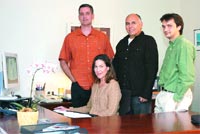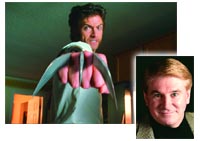
Ascent Media uses ADAM for asset management and maintaining a database.
|
Creators of animations, visual effects and graphics agree that vendors of digital asset management (DAM) solutions don't really understand them.
In their marketing, many vendors emphasize how their DAM solutions can track the whereabouts of millions of digital files on storage systems enterprise-wide so that a particular asset can be retrieved and repurposed to maximize the investment made to acquire or create it. So, for vendors, efficiency boils down to finding stuff.
While tracking assets is vital to high-level graphics and animation work, the experts we spoke with said that's just not enough. What they want are DAM solutions that track the assets in relation to the shots they are in; while tracking the shots in relation to the movies they are in. So, for studios, efficiency boils down to project management.
Post professionals view the project as an asset that's comprised of shots that are assets comprised of elements - such as 3D models, CG characters, background plates, mattes, textures, visual effects, animatics, storyboards and other individual assets. While finding assets quickly and easily saves time and money, asset management conducted in the context of project management significantly improves the efficiency and productivity of the overall operation.

Sony Imageworks' asset management team - (L-R) Manson Jones, Mary Anderson, Bill Villarreal, Sam Richards - works with NXN's Alienbrain.
|
Sony Imageworks
"When vendors talk about asset management, very often they mean finding files in libraries or databases. When we talk about asset management, we mean following the progress of each individual asset as it moves through the workflow pipeline," says Bill Villarreal, VP of technical operations at Sony Pictures Imageworks ( www.imageworks.com/) in Culver City, CA. "If a shot has languished, we want to know what happened to it. We want to quickly gather data that will tell us what's 'holding up the works' on certain assets so we can make changes that get production back on track. Many vendors simply don't get this. NXN does get it, and that's why we're integrating their Alienbrain VFX [ www.nxn-software.com/] solution into our production pipeline."
When Sony Pictures Imageworks began working on Spider-Man, they chose NXN's Alienbrain VFX because it was the first commercial solution to offer both asset management and digital production management of visual effects, digital character animation and full-length CG motion pictures. Villarreal says Alienbrain VFX helps increase productivity and reduce time spent on workflow management tasks from concept to completion.
For Stuart Little 2, which opens this month, Villarreal says that Alienbrain VFX tracked all the digital files used to create the animated character Stuart Little - such as his colors, clothes, textures, whiskers and other attributes. But they also tracked all the different versions of each asset or shot that the directors, producers and art directors had considered but didn't use. Approval information becomes part of the metadata or historical record associated with each asset.
"Throughout the workflow pipeline, artists fill in the metadata fields for each image, noting which assets represent key milestones in the production, such as frames approved by the director or final renderings. The metadata tracks the assets as well as determines which ones are especially important to keep for perpetuity - so we're prepared to retrieve the assets in the event the movie is re-released in the future."
Rhythm & Hues
Six years ago, when Rhythm & Hues (R&H) decided to find a DAM solution that could manage all aspects of the production pipeline - including scanning, design, modeling, CG animation, VFX, film recording and archive - they found there was none.
So, R&H's 12-member software division developed a proprietary solution strictly for in-house use. The result is PTS (or Production Tracking System), which has at its core a powerful DAM solution that currently tracks over 10TBs of data on multiple servers throughout the facility. But, that DAM capability is contained within PTS's sophisticated production management environment, rich with workflow analysis tools for tracking the progress of assets in development.
"Workflow is a very big deal for us here at R&H," says Mark A. Brown, VP of technology, at Rhythm & Hues ( www.rhythm.com/) in Marina del Rey, CA. "Because of the intelligence built into PTS, not only can we find out where a particular asset is, we can see what tasks need to be performed on that asset.
"If an effect shot appears to be behind schedule, we can query the system for 'critical path analysis' to determine where the bottleneck is," continues Brown. "This allows us to find the problem quickly and take action, such as dedicating more artists to it. More importantly, these reports are generated automatically, without our having to physically gather up the data and prepare reports."

Rhythm & Hues' Mark Brown says, "Workflow is a very big deal for us." The studio used its proprietary PTS to track assets for X-Men 2.
|
Efficient production management is especially vital because R&H has several large-scale movie effects projects in the works at once, including Garfield, Scooby-Two, Intolerable Cruelty and Dr. Seuss' Cat in the Hat. PTS also streamlined visual effects and animation work for such movies as X-Men 2, The Ring and Harry Potter and the Sorcerer's Stone.
A Unix-based solution, PTS also incorporates a proprietary virtual file system that makes finding, accessing and converting file formats effortless for the user. And it facilitates the creative collaboration process by enabling digital production supervisors to view shots in progress and then put their notes - such as comments or changes needed - directly onto the images using wireless laptops they carry around the facility, accelerating the creative process.
"It's difficult to estimate what the return on investment has been," says Brown. "But since we put PTS into service, we've saved about 1.5-hours per day over six years, so the savings and productivity increase have been very significant."
Ascent Media
 |
"Asset management is more than storing an asset and maintaining a database. It's the heart of our business," says Chip Aycock, VP of technology for Ascent Media Group ( www.ascentmedia.com/), a provider of creative, media management, and network distribution services in Hollywood. "Our vision is to treat an asset as a part of a media lifecycle. At any point in that lifecycle, an asset may have a specific function and usage for which we provide services. But it is also a part of a larger lifecycle that includes the parent elements from which it came, and the later forms of re-purposing and exploitation that will occur throughout its distribution windows," Recently, Ascent Media chose a DAM solution by The ADAM Systems Group ( www.adamsystems.com/). ADAM Systems' new E-Series is a scalable product family of customized DAM solutions that gives the graphics, animation and special effects community a way to securely catalog, share, archive, track, preserve and distribute CGI, video, audio files and other assets, while providing advanced workflow automation features and a wide array of digital media processing and management functions.
With storage for over a dozen Petabytes of data, Ascent Media manages a wide range of assets, including 1080/24p HD features, TV shows, commercials, DVD aggregation files, graphic reels, still images, promotional materials, to name a few. And assets are tracked along with extensive metadata detailing their progress through the media lifecycle.
In asset management, "The problem for graphics is that they are both essence data [original source material] and metadata. And oftentimes, once the composited parent files are completed, the composite layers used to create them are discarded along with the metadata that establishes their relationship. DAM systems must not only [track] the essence data, but the metadata to ensure efficient data mining for more efficient re-purposing," Aycock explains. "Another challenge is that there is a general lack of common metadata schema for most of the file types in the media and entertainment industry. If you have a lot of asset management systems in the marketplace, and each is using a separate, non-extensible metadata schema, then for the content owner there is a significant hurdle in managing their data in cross-platform, multi-vendor environments."
RED
"Most DAM vendors completely fail to understand that in post production we work on images, which are part of clips, and we need to be able to see the content in either mode," says Simon Leppington, technical director at Red ( www.red.co.uk/) in London.
"What we need is a DAM solution that enables us to find images automatically across our network of disk arrays containing many terabytes of disk space, whether they're downstream from the HD telecine or on one of our Discreet systems. And, we need an easy-to-use GUI that lets everyone see proxies of all the images as well as the clips associated with a project," adds Leppington.
Recently, Red found a cost-effective solution targeted to post - called Critter by SALT ( www.s-a-l-t.co.uk/), and since installing it they've added the (optional) specialized Discreet storage interface. Critter helps everyone at Red automatically locate and access TBs of data, stored in virtually every image file format, on the facility's network of disk arrays, as well as the data tape archives.
"There's also a really elegant feature where, if you have multiple workstations, they find each other and end up sharing their information in just one central database automatically," says Leppington. Red also offers its customers an FTP site server so they can access the assets related to work in progress, as well as stream media to their desktop via Red's password-protected, standard Web browser.
Telepictures
Another problem that's unique to post production is dealing with unusual digital image file formats, such as ones created on Quantel workstations. With its 15-member graphics department working on all types of Quantel workstations - including Quantel Paintbox FAT and Hal - LA's Telepictures says its choice of Proximity's DAM solution was a no-brainer because it can link to Quantel systems and storage directly.
Not only does it directly support Quantel formatted files, it also manages files created on their many other workstations, including Discreet Flame and Smoke; Apple Final Cut Pro, and Adobe After Effects and Illustrator.
"When we first saw Proximity in 1994, and realized what it could do for us, we knew there was no other option. We envision using our Quantel workstations for graphics creation for many more years. While Quantel is adopting an open architecture now, their previous generation of systems were closed and proprietary. Proximity worked very closely with Quantel to enable their DAM to handle Quantel files stored on Quantel drives and integrate them with other leading image file formats used by this industry," says Gavin Nex, chief engineer, Telepictures, Inc., a division of Warner Bros. ( www.warnerbros.com/).
Proximity ( www.proximitygroup.com/) offers several complementary software products, including Xenomax, which provides image browse, transfer and transcode functions from a standard Web-browser; and Xenostore, the content management utility offering a single searchable media catalog and an independent storage area for full resolution images stored in their native formats. While Telepictures uses both of those, they will soon upgrade to Proximity's new Xenomotion, which offers video clip integration, metadata capture and creation and realtime or faster transcoding between a wide range of file formats and bitrates.
Telepictures purchased Proximity's DAM to track graphics created by in-house artists as well as still images licensed from AP Graphics Bank and other third-party vendors to support Extra, its long-running magazine show.
"We used to buy the rights to use an image of Harrison Ford without realizing that we already had a picture of him in our archives that we had already paid for. With Proximity, the ability to find and re-use what we already have has greatly accelerated the production process," says Nex.
Besides Extra, Telepictures also produces Celebrity Justice, featuring the real-life courtroom dramas of stars like Winona Ryder and Robert Blake. There are also many reality shows in the works, including The Bachelor 4, as well as the new NBC daytime talk show The Ellen DeGeneres Show, all of which require extensive graphics support.
DreamWorks
Besides providing support for their creative work, studios are also turning to DAM solutions to improve their marketing operations. To automate and streamline its international theatrical marketing, through more efficient distribution of digital media assets to all its vendors worldwide, DreamWorks installed TEAMS by Artesia ( www.artesia.com/) in 2002. While DreamWorks calls its installation DART - Digital Asset Resource Tracking - it is in fact TEAMS, a highly customizable, user-definable, data-driven DAM solution that serves as the single access point to track, access, preview and distribute all digital media files and their metadata over an enterprise-wide architecture.
"We had a compelling need to move an ever-growing number of digital media assets around our facility, as well as to our vendors overseas, so that our feature film marketing efforts could be handled in the most efficient, consistent and cost-effective manner," says Craig Fujimoto, director of application development for DreamWorks SKG ( www.dreamworks.com/) in Glendale, CA. "The problem is that we have tens of thousands of assets - for printed posters and advertising as well as movie trailers, graphics, and more - and there are often foreign language versions of each. The original assets and all of its derivations must be tracked, accessed and distributed."
DreamWorks now has Shrek 2 in the works, as well as other animated features, including: Madagascar, Over the Hedge and Sinbad: The Legend of the Seven Seas.
"Rather than continuing in a 'free for all' manner, burning CDs and shipping assets back and forth, we implemented this new 'digital communications pipeline' to allow all our marketing people direct, secure, global Web-based access to the graphics they need for timely promotion," explains Fujimoto. "The metadata associated with each file tells them the whole story."